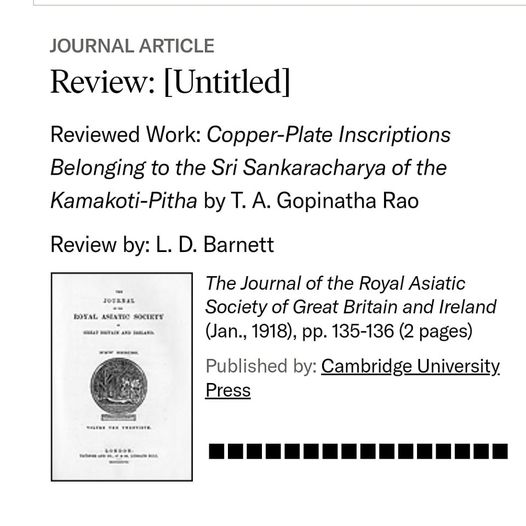COPPER-PLATE INSCRIPTIONS BELONGING TO THE SRI SANKARACHARYA OF THE KAMAKOTI-PITHA. Edited By T. A. GOPINATHA RAO, M.A. Madras, (1917) – Book Review By L.D. BARNETT
In this volume Mr. Gopinatha Rao gives the text and translation of ten grants engraved on copper-plates, which belong to the monastery at Kumbakonam, known as the Kama-kōti-pitha, one of the establishments claiming descent from the great Sankaracharya.
The documents comprise grants of Vijaya-ganda-gopala (circa A.D. 1260),
Vira Narasimhha-deva (Saka 1429), Krishna-deva-rāya (Saka 1444 and 1450),
Vijaya Raghunatha Tondaiman of Pudukōṭṭai (Saka 1613), Vijayaranga Chokkanatha Nayanayyavaru (Saka 1630), and one of the Emperors of Delhi (Hijra 1088), together with a fragment of a grant issued by one of the Vijayanagara kings of the last dynasty and a document of Saka 1608, which is interesting from its mention of Akkanna and Madanna, the notorious favourites of the Kutb Shahi Sultan Abu’l-Hasan of Golkonda.
They are in Sanskrit, Tamil, Telugu, and even (in the case of the Delhi firman) Persian transliterated into the Telugu character.
In our opinion the editor would have done well to transcribe each document in the script in which it is actually written, or else into Roman; instead of doing so, however, he has given alike the Sanskrit, the Telugu, and the Persian in Nagari character. In defence of this course he may plead the example of certain distinguished writers in the Epigraphia Indica; but two blacks do not make a white, and the transliteration of a complicated Southern alphabet like Telugu into such a disparate script as Nagari leads to most unhappy results.
Apart from this minor point, the work is carefully and correctly done-perhaps a little too correctly, for the learned editor has given in his notes the correct forms for all vulgar and archaic spellings, which is hardly necessary in every case and is illustrated by good plates. The only real desideratum is an index.
L. D. BARNETT.

